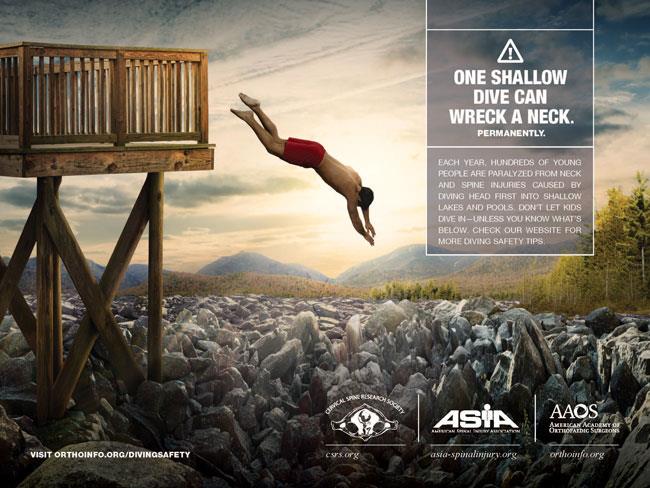Staying Healthy
Diving Safety
One Shallow Dive Can Wreck a Neck.
"Each summer, orthopaedic surgeons see emergency room patients who dive head first into shallow water, break their necks, and are paralyzed," said orthopaedic surgeon Richard S. Siegel MD, author of an Ortho-pinion on diving safety for A Nation in Motion, the AAOS' award-winning public awareness campaign.
Nearly 26,000 individuals are treated in emergency departments, doctors' offices and clinics for diving-related injuries in the U.S. each year, according to the U.S. Consumer Product Safety Commission (CPSC). Approximately 800 of those injuries—primarily teens and young adult males—are paralyzed due to diving in water that is too shallow.
"Their friends pull them from the water because they are unable to move their arms and legs, and can't breathe. Knowing when and how to dive safely prevents these catastrophic injuries," says Dr. Siegel. "If the water is not twice your height, or if you are uncertain of its depth, go feet first."
Diving Safety Statistics
The statistics below describe the incidence and cost of diving injuries in the United States:
- 25,832 diving injuries were treated in U.S. emergency departments, doctors' offices and clinics in 2013, according to the U.S. Consumer Product Safety Commission (CPSC).
- Swimming and diving injuries are most common among children ages 17 and younger.
- Diving injuries cost nearly $1.8 billion each year in medical, loss of work, pain and suffering and legal/liability expenses.
Tips for Safe Diving
To be safe when diving, keep in mind these important tips:
- Never dive into shallow water. Before diving, inspect the depth of the water to make sure it is deep enough for diving. If diving from a high point, make sure the bottom of the body of water is double the distance from which you're diving. For example, if you plan to dive from eight feet above the water, make sure the bottom of the body of water, or any rocks, boulders or other impediments are at least 16 feet under water.
- If you have any doubt about water depth, enter the water feet first.
- Never dive into above-ground pools.
- Never dive into water that is not clear, such as a lake or ocean, where sand bars or objects below the surface may be obstructed or not visible.
- Only one person at a time should stand on a diving board. Dive only off the end of the board and do not run on the board. Do not try to dive far out or bounce more than once. Swim away from the board immediately afterward to make room for the next diver.
- Do not drink alcohol before or during swimming, diving, or boating. Alcohol affects balance, coordination, and judgment.
Last Reviewed
January 2015
AAOS does not endorse any treatments, procedures, products, or physicians referenced herein. This information is provided as an educational service and is not intended to serve as medical advice. Anyone seeking specific orthopaedic advice or assistance should consult his or her orthopaedic surgeon, or locate one in your area through the AAOS Find an Orthopaedist program on this website.







